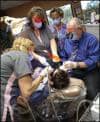by Andrew M. Sicklick, DDS
General dentists who perform orthodontic work should be educated, not berated

A few years later, upon entering our orthodontic residency, my colleagues and I took a 2-hour “pretest.” This test made it very clear to us that we knew no orthodontics. We came from different schools, and some of us may have been in an accelerated or honors orthodontic program in dental school, but we still did not know orthodontics. A few were familiar and comfortable with cementing appliances, bonding brackets, and fitting retainers, but diagnosis and treatment planning were foreign languages to each of us.
During my residency, on some days I was responsible for supervising the orthodontic treatment being provided by the pediatric dental residents. I was supposed to check each bonded bracket’s position before it was cured on to a tooth. On one occasion, a resident called me over to see the patient that she had just finished bonding, and said, “It doesn’t matter where on the tooth you place the bracket, right?”
Everyone knows general dentists who are using aligners to treat patients. Companies provide simplified appliance systems, and all dentists have the technical ability to use them properly.
All licensed dentists have the right to practice all areas of dentistry, including orthodontics. Endodontists do not have a monopoly on root canal therapy. Prosthodontists do not have a monopoly on replacing teeth. Periodontists do not have a monopoly on gum treatments. Pediatric dentists do not have a monopoly on treating young patients. Oral surgeons do not have a monopoly on extractions.
Dental students’ exposure to orthodontics is extremely limited. Clinical, comprehensive treatment planning usually ignores orthodontic possibilities. How many patients have been told that the only way to treat their maxillary anterior spacing is with four veneers? I once heard that “the best method for molar uprighting is a 556 bur.”
Our professional responsibility is to always provide the best care for our patients. Any necessary treatment should be both accessible and affordable. For comprehensive cases, clear communication and coordination, with easy periodic review by all involved, is tremendously helpful. General dentists are the only dentists who patients visit regularly. They have a long-term relationship with patients and their families, and they are the first oral health provider to see any oral condition.
It seems reasonable to expect general dentists to recognize and understand orthodontic diagnosis and treatment options. The more familiarity that they have with orthodontics, the more likely that they will see the need for and benefits of treatment. With better experience, general dentists will be more likely to incorporate orthodontics into all of their patients’ diagnoses. General dentists decide, on an individual basis, when to refer patients to a specialist. This decision is based on the dentist’s comfort level with the expected procedure, as well as the expected difficulty of the specific patient’s needs.
This system of generalists providing most care, and specialists treating only difficult cases, is the accepted standard throughout health care. Nearly all dental specialties operate under the same principle. Very few patients schedule appointments to see an endodontist or oral surgeon without having been examined and referred by their general dentist. Orthodontics has been the lone holdout for a very long time. Through the expected and perceived simplicity of removable appliances, especially with the lack of needed inventory stock, and with greater orthodontic education at the predoctoral level, orthodontics will become like these other specialties.
As specialists, orthodontists can react to this trend in one of two ways. The first possibility is to denigrate general dentists who are perceived to be operating in areas beyond their training, and to try to insist that only orthodontists provide orthodontic care. It would be a reaction to a perceived threat of substandard patient care as well as to economic drains on orthodontists. The second response is to continue to educate general dentists so that their recognition of orthodontic problems and benefits is more refined. This would grant patients better, more comprehensive care. Most general dentists would continue to treat cases that they could successfully complete, and the overwhelming majority of patients would still be treated in orthodontic practices. Overall, more patients would receive the orthodontic care that they need.
The specialty of orthodontics is at a crossroads. Outside influences are changing its relationship with the public. As a profession, our primary obligation is always to demand that patient needs and concerns are addressed in the best way possible.
Andrew M. Sicklick, DDS, is a clinical assistant professor of orthodontics at Montefiore Medical Center, the Bronx, NY. He is in private practice in Cedarhurst and the Bronx, NY. He can be reached at (516) 569-5559 or [email protected].





